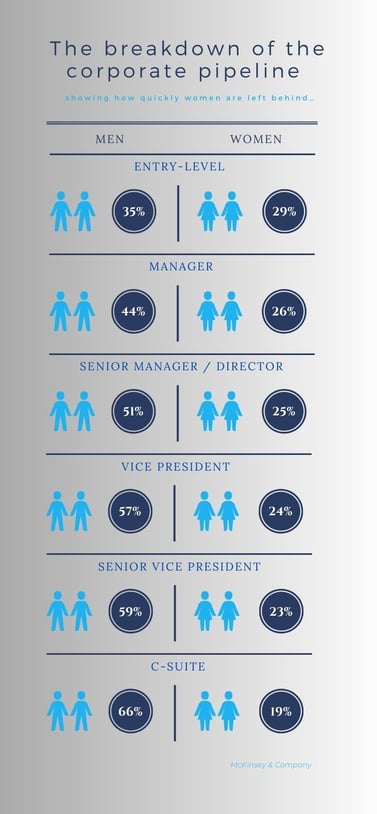Despite modest progress, terms like the “broken rung”, the “glass ceiling”, or the “broken ladder” have made their appearance over the years, highlighting the barriers women are still facing in the tech sector and how dramatically underrepresented they remain in leadership roles. Recently, yet another term has made the headlines: the “Great Breakup”, along with the question, “why female leadership in tech is falling?”

The tech industry has never been viewed as a particularly female-friendly field, with a persistent gender imbalance that has resulted in a disproportionately low number of women in leadership positions. Despite ongoing efforts to increase diversity and inclusion in the workplace, progress has been slow, and this new emerging trend showcases just how the already thin ranks of high-profile women leaders in tech have further lessened over the past few years.
YouTube's former CEO, Susan Wojcicki and Meta's former chief business officer, Marne Levine, are just a couple of the many cases to have recently joined the growing number of women in senior positions stepping away from their companies. Women leaders are now breaking up with their employers at the highest rates we've ever seen, and aspiring young women are prepared to do the same. This phenomenon is alarming, not only for the companies themselves but also for the broader tech industry, as it threatens to undermine the progress made in recent years towards gender equality in tech.
In this blog post, we will explore the causes of the “Great Breakup“, its impact on women in leadership positions, as well as the steps that can be taken to address this issue and promote greater gender diversity in tech and beyond.
Setting the Scene
Technology has become an integral part of modern life and has transformed every aspect of society. However, despite the term "technology" being associated with innovation and progress, gender disparities in employment continue to persist. When analysing statistics and trends of women working in technology, studies reveal significant gender gaps in STEM education, attrition and retention, as well as leadership position gaps.
- According to Tech She Can, a mere 27% of women in the age group of A-level and university are interested in pursuing careers in the technology field, whereas 62% of males express interest in the same. Additionally, only 3% of females consider technology as their first-choice career.
- Stats from Tech Nation also suggest that only 26% of the tech workforce are women, and this figure is even less for black and Hispanic women at just 3% and Asian women at just 5%.
- Moreover, women in technology are nearly twice as likely than women in other industries to consider leaving the workforce for reasons related to stress/burnout, gender pay gaps, lack of work-life balance, unequal promotions, constant undervaluation, and lack of diversity at their company. Not only are women getting paid less than men for doing the same job, but they’re also still experiencing a highly toxic “bro culture” in many workplaces, which makes them feel unwelcomed and intimidated.

When it comes to women in tech leadership roles, the gap becomes even more profound. McKinsey's recent report highlights that only one in four C-suite leaders is a woman, and only one in 20 C-suite leaders is a woman of colour. Additionally, there the "broken rung" issue, where fewer women than men are promoted into management positions, remains: For every 100 men promoted from entry-level to manager, only 87 women are promoted. These dynamics are even more pronounced for black women, for whom that number is only 82.
With this in mind, there’s no surprise that the number of women in tech leadership roles remains low. DDI's research over the past two decades indicates that the number of women in technology leadership roles has only ever reached 33%. And although some companies, such as Meta and Alphabet, have reported higher levels of women leaders over the years, across the entire tech sector, the percentage of women in tech leadership roles is trending down – currently at 28%, according to DDI's Global Leadership Forecast.
Pandemic-related issues around additional responsibilities like caregiving and the insular nature of the industry are likely the two main reasons behind the significant drop, only adding to the disproportionate inequity, stress, and burnout women faced before lockdowns. After the pandemic, they had to re-think what they wanted from their careers, and one thing was made clear: Women leaders were not comfortable with the status quo, didn't want to return to business as usual, and were ready to do something about it.
Now, in the midst of a "Great Breakup", women leaders demand more from work and are more likely to switch jobs to meet their needs. In fact, the number of women in leadership roles leaving their companies is at the highest rate ever. This spike in departures is both surprising and concerning, especially for companies and organisations now hanging on by a thread to hold onto the relatively few women leaders they have.
What Is the Great Breakup?
The term was coined by McKinsey and made its first appearance in their latest Women in the Workplace report, conducted in partnership with LeanIn.Org.
The “Great Breakup” refers to the rising trend of women in leadership positions choosing to leave their companies as a response to being constantly undermined, overlooked and overworked compared to their male (often white) counterparts. Instead of remaining in a company where they feel undervalued, they are choosing to part ways with their current employers and seek out better career opportunities elsewhere.
Similar to the other “great” trends, like the “Great Resignation” and the “Great Layoffs”, the “Great Breakup” can be traced back to the pandemic, when women, in particular, were faced with the dual responsibility of homeschooling and working from home at the same time, leading to overwhelming stress and burnout. Shockingly, almost half of all female leaders are experiencing burnout, which is a much higher percentage compared to only 31% of male leaders. Coupled with the chronic underrepresentation of women in the tech industry and being passed over for promotions, many women leaders are now leaving their jobs in record numbers to work for companies that prioritise diversity, equity, and inclusion (DEI), flexibility, and a better work-life balance.
The Great Resignation vs the Great Breakup
The "Great Breakup" is not just another term for the "Great Resignation", despite what some may think.
The “Great Breakup” isn't about breaking up with tech; it's about demanding more and better. Senior women are not exiting the workforce nor quitting their positions for better-paying jobs elsewhere. They're actively leaving organisations they don't align with anymore. In that sense, the "Great Breakup" reflects a newfound confidence among women in tech, particularly those in senior leadership positions, who are seeking out companies that share their values, including prioritising career growth, supporting work-life balance and flexibility, and emphasising diversity and inclusion.
As more workplaces require employees to return to the office, it's not surprising that this is happening. According to McKinsey's survey, while almost 20% of men want to primarily work on-site, only 10% of women, who often shoulder the primary caregiving responsibilities, feel the same.

The Pipeline Problem
Women are demanding more from work, and they're leaving their companies in record numbers to get it. The rate at which women leaders are switching jobs is the highest we've ever seen – and even at higher rates than men in leadership. What's more, this trend has also caught the attention of aspiring young women who are now considering whether breaking up with their employers is the best way to advance their careers.
This could have serious implications for organisations, who are now presented with a new pipeline problem. While women continue to be underrepresented in leadership roles due to the "broken rung" at the first step up to management, many companies are now also mourning the loss of their precious few women leaders. For enterprises, this also translates to a loss of revenue: companies with gender diversity on executive teams have been shown to be 25% more likely to have above-average profitability than those without.
The report by McKinsey and LeanIn.Org makes a number of findings that put the scale of this "great problem" into perspective:
- Only one in four C-suite leaders is a woman and only 1 in 20 is a woman of colour.
- For every woman at the director level who gets promoted, two women directors choose to leave their company.
As an increasing number of women leaders vote with their feet, it raises the question of what factors are driving their decision and what measures companies can take to retain female talent.
What Is Causing the Great Breakup?
The reasons women leaders are leaving their companies are telling. Despite being just as ambitious as their male counterparts, women often encounter obstacles that make it harder for them to advance, so they decide to leave. Here are the main factors driving their decision:
- Women are still experiencing microaggressions that undermine their authority.
- Women leaders are still being overlooked, overworked and under-compensated.
- Women are expecting more from their managers, but they can’t deliver due to inadequate trailing.
- Women, particularly those under 30, are demanding a better culture of work, more flexibility and better work-life balance.

Women Are Still Experiencing Microaggressions
Women leaders share the same aspirations for career advancement as their male counterparts, but they face more obstacles due to unconscious bias in the workplace. Performance bias and microaggressions are two key areas where gender inequality is prevalent, with 37% of women leaders reporting that a co-worker took credit for their idea, compared to 27% of men leaders. Moreover, women leaders are twice as likely to be mistaken for someone more junior and often have colleagues question their qualifications for their job. Women leaders are also more likely to report that personal characteristics, such as their gender or being a parent, have played a role in them being denied or passed over for a raise, promotion, or opportunity to advance.
However, women face bias not just due to their gender but also due to their race, sexual orientation, disability, and other aspects of their identity. This compounded discrimination can create even greater obstacles for these groups of women, including increased microaggressions and barriers to advancement. For example, despite receiving less support, BAME women exhibit greater ambition, with 41% of them aspiring to be top executives compared to just 27% of white women, according to the Women in the Workplace report.
So, while the importance of diversity, equity, and inclusion (DEI) is increasingly recognised in the workplace, many women leaders are still leaving (or pushed out of) their companies due to a lack of inclusive cultures. However, they are not leaving the workforce altogether; instead, they are seeking better opportunities in companies that prioritise their values and offer a more supportive work environment.
Women Leaders Are Overworked but Underpaid
Over the last couple of years, companies have been expecting more from women leaders within their organisations when it comes to people management and diversity, equity, and inclusion (DEI) initiatives. Indeed, according to McKinsey’s report, women in leadership positions are two times more likely than men leaders to spend a significant amount of time on DEI initiatives since they still face more biases and barriers in the workplace. Yet, 40% of these women say they are not actually recognised or rewarded for that.
But the burden was never equally spread. From the moment women entered the workforce, they were unofficially assigned additional work, like making coffees, taking notes, organising events or buying presents for colleagues. And the era of this emotional labour is not over yet. Women already doing more unpaid work at home than men are now spending extra time and energy on unrecognised office housework that makes it even harder for them to advance. At the same time, this unpaid work also means that women leaders are being stretched thinner than men in leadership. Not surprisingly, 43% of women leaders are burned out, compared to only 31% of men at their level.
While women leaders make significant contributions to employee well-being, retention, and satisfaction in the workplace, they’re often just left feeling exhausted, disappointed, and unappreciated. And when employees feel like this, they’re more likely to seek opportunities elsewhere where their efforts will be acknowledged and rewarded.

Women Leaders Expect More from Their Managers
Managers play a crucial role in shaping workplace culture, particularly for women, who value having a supportive manager when deciding to join or stay with a company. When managers invest in people management and DEI, women are happier and less burned out. They're also more likely to recommend their company as a good place to work and less likely to think about leaving their jobs, which translates to better recruiting and higher retention.
However, today there is a growing gap between what is expected of managers and how they are trained and rewarded. McKinsey's report shows that less than 50% of manager training addresses important topics such as preventing employee burnout and ensuring equitable promotions. Additionally, only 25% of companies factor in employee retention and 34% consider progress on DEI in managers' performance evaluations.
Another gap that needs to be addressed is regarding the creation of inclusive remote and hybrid working environments. Employees who have the option to work remotely or on-site are happier, less burned out, and less likely to consider leaving their companies. However, only a few managers receive this training or have access to tracking tools to measure their effectiveness, and just 17% of companies measure attrition between on-site and off-site employees.
This disparity between what is expected of managers and what they are (not) trained to do to meet these demands is evident in the way they show up. Roughly 50% of women report that their manager regularly fosters a culture of respect within their team, and less than 50% indicate that their manager demonstrates an interest in their career development or helps them manage their workload. Training and supporting managers in creating inclusive – on-site, remote or hybrid – work environments is critical for retaining top talent and promoting equity in the workplace. Companies that fail to invest in these efforts risk losing valuable women leaders and may even watch their top talent leave for competitors.
Women Demand More Work-Life Balance
Research has shown that women employees who can choose to work in the arrangement they prefer—whether remote or on-site—are less burned out, happier in their jobs, and much less likely to leave their companies. This indicates not only that having a choice is critical for talent retention but also that “one size fits all” when it comes to work options is not relevant anymore.
The option to work remotely, for instance, is particularly important to women: Only one in ten women want to work mainly on-site, while remote and hybrid work options are often cited by them as one of the primary reasons for joining or remaining with an organisation. And although flexibility is important, these preferences extend far beyond that. Women who work remotely – at least some of the time – report lower instances of microaggressions and increased psychological safety. This effect is especially evident for women from marginalised groups, such as women of colour, LGBTQ+ women, and women with disabilities, who frequently encounter demeaning and exclusionary behaviours.
The demand for more flexibility and better work-life balance is even more pronounced in the next generation of women leaders. The Women in The Workplace 2022 report revealed that almost two-thirds of women under 30 say they would be more interested in advancing their careers if they saw senior leaders who had the work-life balance they wanted. Young women are ambitious, and they want to work and progress. However, they’re not willing to settle for positions that don’t prioritise their well-being or allow them to have a sustainable work-life balance.

From Breaking Up to Making Up – How to Retain Women Leaders
The bad news is that increasingly more women leaders are leaving their companies. The good news is that employers now have both the knowledge of what has caused this spike in departures and the power to translate it into organisational change. Here's how companies can turn the "Great Breakup" into a great make-up:
-
Fixing the "Broken Rung"
With men significantly outnumbering women at the manager level, there are simply not enough women to promote to leadership positions. To address this "broken rung", companies can implement several solutions, such as ensuring equitable promotion rates for both men and women while monitoring outcomes. Other approaches include introducing performance metrics for diversity, equity, and inclusion efforts and implementing safeguards to evaluate remote or hybrid workers based on measurable outcomes rather than when or where they work.
-
Offering Flexible Working Options, But…
Adopting remote or hybrid working policies is a positive step towards improving recruiting and retaining senior-level female talent. However, it's neither a panacea for systemic change nor a substitute for creating a truly inclusive work culture.
While most women who work from home report experiencing fewer microaggressions, it's also possible that they're missing out on recognition and advancement opportunities. Women are more likely to be the primary caregiver, leading to higher rates of working from home, which may unintentionally entrench inequality rather than ease it. Moreover, the social stigma that portrays mothers who work on-site as "not caring" and men who stay home caring for their children as "lazy" is also deeply problematic and needs to change.
Relying solely on remote and hybrid work as a solution is insufficient. Companies must invest in creating an inclusive culture, evaluating employees based on their accomplishments, leadership effectiveness, and business results, regardless of their working arrangements.
-
Prioritising Manager Training
The role of managers in shaping women's work experiences and retaining female talent cannot be overstated. A supportive manager who prioritises their wellbeing is crucial for women and ranks among the top three factors influencing their decision to join or remain with a company.
Investing in management training is essential for increasing job satisfaction and reducing burnout among women, resulting in improved recruitment and retention of female leaders. Additionally, employers must recognise the importance of people management skills in performance evaluations and support women leaders to succeed in their roles.

-
Promoting Cultural Change
Nowadays, more women leaders are willing to leave workplaces that lack diversity and inclusivity and join those that embrace it. Companies must make their workplaces more inclusive by fully endorsing and transparently implementing DEI efforts to retain female talent and attract the next generation of women leaders.
Holding leaders accountable for progress in this area can help achieve positive steps. Senior executives can show strong and visible support for DEI initiatives by participating actively in related training and events and communicating the importance of these efforts across the organisation. Moreover, raising awareness of the challenges faced by women, particularly those with traditionally marginalised identities, and the benefits of a more diverse and inclusive workplace can also help foster cultural changes. Companies can promote this awareness through various initiatives such as mandatory training on unconscious bias and open conversations for employees to share their perspectives and suggestions for enhancing diversity, equity and inclusivity.
Ready for Change?
Did you know that a more diverse and inclusive approach to recruitment is the first step towards achieving a more equitable future in tech?
Templeton has 27 years of experience recruiting highly skilled and diverse IT contractors across the world – find out more about our award-winning tech recruitment services.
Are you looking for a role in IT?
We provide contract tech jobs in 40 countries worldwide, and our diverse, international team is on a mission to find the right one for you. Get in touch with us today!
Don’t miss out on – Women in IT: Climbing the Ladder of Success




